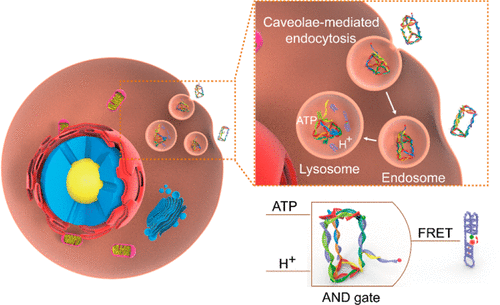Our official English website, www.x-mol.net, welcomes your
feedback! (Note: you will need to create a separate account there.)
DNA Logic Operations in Living Cells Utilizing Lysosome-Recognizing Framework Nucleic Acid Nanodevices for Subcellular Imaging.
ACS Nano ( IF 15.8 ) Pub Date : 2019-04-12 00:00:00 , DOI: 10.1021/acsnano.9b01324 Yi Du 1 , Pai Peng 1 , Tao Li 1
ACS Nano ( IF 15.8 ) Pub Date : 2019-04-12 00:00:00 , DOI: 10.1021/acsnano.9b01324 Yi Du 1 , Pai Peng 1 , Tao Li 1
Affiliation

|
DNA logic nanodevices that in situ operate within living cells have attracted increasing interest and shown great promise for gene regulation and target recognition. A challenge remains how to control their activation inside specific cellular compartments. Toward this goal, here we report a lysosome-recognizing framework nucleic acid (FNA) nanodevice using an i-motif and an ATP-binding aptamer (ABA) incorporated into a DNA triangular prism (DTP) as the logic-controlling units. Once entering the lysosomal compartments, the FNA device responds to lysosomal pH and ATP via the folding of i-motif and ABA, which triggers a structural change of FNA and the release of a reporter structure for subcellular imaging. With endogenous proton and ATP as two inputs, an AND logic gate is built and in situ operated within living lysosomes by pH and ATP modulation with external drug stimuli. Given the abnormal levels of pH and ATP within some cancer cells or dysfunctional lysosomal cells, in this context our designed FNA logic device may find extended applications in controllable drug release and disease treatment.
中文翻译:

利用溶酶体识别框架核酸纳米器件的亚细胞成像在活细胞中的DNA逻辑操作。
在活细胞内原位运行的DNA逻辑纳米器件引起了越来越多的兴趣,并显示出对基因调控和靶标识别的巨大希望。如何控制它们在特定细胞室内的激活仍然是一个挑战。为了实现这一目标,我们在这里报告了溶酶体识别框架核酸(FNA)纳米器件,它使用掺入DNA三角棱镜(DTP)中的i-基序和ATP结合适体(ABA)作为逻辑控制单元。一旦进入溶酶体区室,FNA设备就会通过i-基序和ABA的折叠来响应溶酶体的pH和ATP ,从而触发FNA的结构变化并释放用于亚细胞成像的报告结构。以内生质子和ATP作为两个输入,构建了一个AND逻辑门,通过外部药物刺激通过pH和ATP调节,在活的溶酶体内进行原位操作。考虑到某些癌细胞或功能异常的溶酶体细胞中pH和ATP的异常水平,在这种情况下,我们设计的FNA逻辑设备可能会在可控药物释放和疾病治疗中找到扩展的应用。
更新日期:2019-04-12
中文翻译:

利用溶酶体识别框架核酸纳米器件的亚细胞成像在活细胞中的DNA逻辑操作。
在活细胞内原位运行的DNA逻辑纳米器件引起了越来越多的兴趣,并显示出对基因调控和靶标识别的巨大希望。如何控制它们在特定细胞室内的激活仍然是一个挑战。为了实现这一目标,我们在这里报告了溶酶体识别框架核酸(FNA)纳米器件,它使用掺入DNA三角棱镜(DTP)中的i-基序和ATP结合适体(ABA)作为逻辑控制单元。一旦进入溶酶体区室,FNA设备就会通过i-基序和ABA的折叠来响应溶酶体的pH和ATP ,从而触发FNA的结构变化并释放用于亚细胞成像的报告结构。以内生质子和ATP作为两个输入,构建了一个AND逻辑门,通过外部药物刺激通过pH和ATP调节,在活的溶酶体内进行原位操作。考虑到某些癌细胞或功能异常的溶酶体细胞中pH和ATP的异常水平,在这种情况下,我们设计的FNA逻辑设备可能会在可控药物释放和疾病治疗中找到扩展的应用。















































 京公网安备 11010802027423号
京公网安备 11010802027423号